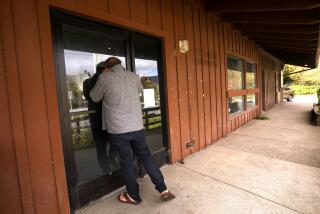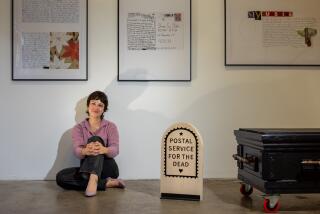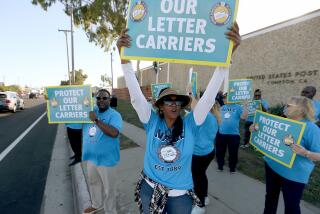Mailman Delivers a Little Normality to French Quarter
NEW ORLEANS â When Sandra Bowling saw James Gath walking down Decatur Street here in the French Quarter the other day, she was so excited that she bounded out of her chair at the Angeli Cafe, ran out the door and hugged him.
âHow you doing, honey?â Gath asked Bowling.
âOh, Iâve missed you,â Bowling replied.
Gath is her mailman.
âIâll never take mail for granted again,â said Bowling, a concierge at Le Richelieu Hotel. âWhen I got my first delivery back again, I was so happy, even though it was a bunch of bills.
âIt felt like some important degree of normality was returning to my life,â Bowling said. âIt was reassuring.... This little chime really did go off in my head: âYouâve got mail!â â
Normality is still a ways off for most mail routes in New Orleans, where neighborhoods are so damaged and residents so dispersed that home delivery is pointless, even impossible.
But the United States Postal Service is doing its best to move the mail. It is making deliveries, if sporadically, to about 38% of its routes in New Orleans -- including Gathâs circuit. It has established mail pickup locations for every ZIP Code representing a flood-damaged area, with several covered by a large complex of trailers and mobile vending sites at a parking lot next to the Superdome.
It also is processing a huge volume of mail-forwarding requests -- 325,000 households -- from the post-Katrina diaspora.
Gath -- a muscular ex-Marine who rode out the storm with relatives in Shreveport, La., and came home to find two rental units he owns in ruins and his French Quarter apartment plagued by mold and a leaky roof -- said he felt like âone of the lucky onesâ to be back at his job.
In ordinary times, Gath delivered mail to residents and businesses in the eastern section of the French Quarter, past walk-up outdoor bars and stores that sell items such as fake blood, Mardi Gras beads and âvoodoo gear.â
As he made his rounds after the storm, grateful customers greeted him by name.
An eight-year postal service employee with a friendly laugh, Gath not only stops and chats with folks he delivers mail to -- he lives among them.
âI got nobody to complain to about not getting my mail,â he said. âIf I want to say, âHey, whereâs my check?â I basically have to gripe to myself.â
Gath says flashes of New Orleansâ devil-may-care spirit are slowly returning to his 12-square-block delivery area.
But the atmosphere largely is somber, and reunions often emotional.
Young men and women with neon-dyed hair, multiple piercings and tattoos mingle with armed National Guard soldiers. Neighbors who have not seen each other in weeks hug when they meet on the street.
The other day, Gath had just parked his mail truck on Decatur Street, loaded stacks of mail into his blue Postal Service bag and started walking his rounds when another woman came up and hugged him.
âI just got back, and boy am I happy to see you,â said Maida Torres, a French Quarter resident who described her occupation as âwhatever I feel like doing.â
After Katrina struck, Torres had spent her first two nights of refuge at a former prison camp-turned-shelter in Tennessee, then spent seven weeks with a family outside Crossville, Tenn. She returned to New Orleans about two weeks ago.
Seeing Gath, she said, felt like a part of the fabric of her life was coming back together.
âHeâs a good mailman,â she said, squeezing Gath on the elbow. âAnd itâs a hard job. This is a really, really transient area. You have to know whatâs going on in order to get the right mail to the right people.â
Dave Lewin, a postal service spokesman, said there were about 4,000 employees in the New Orleans area before Katrina. Although there are no exact figures on how many have returned to their jobs, the rough estimate is that it is a bit less than 50% in the city, and a bit more in the surrounding areas.
To expedite service here, the post office is delivering only first-class, priority and express mail to some areas.
Gath said that if it looked like no one was around at a particular location, he would attempt delivery for 10 days; if the intended recipient was still not there and had not filed a change-of-address form, he said, the mail would be returned to its sender.
Following this procedure, he said, he is delivering only about half the normal amount of mail. But itâs an important start to recovery, he said.
âI feel like Iâm a part of that,â said Gath, who confessed to loneliness in the post-Katrina world: His three sisters have relocated to Houston, perhaps for good, and many friends are gone.
âItâs tough,â Gath said, adding that his job helps him keep going.
âI like being back in the rhythm of delivering the mail. Itâs a connection. It helps take my mind off of everything thatâs been lost.â
More to Read
Sign up for Essential California
The most important California stories and recommendations in your inbox every morning.
You may occasionally receive promotional content from the Los Angeles Times.










